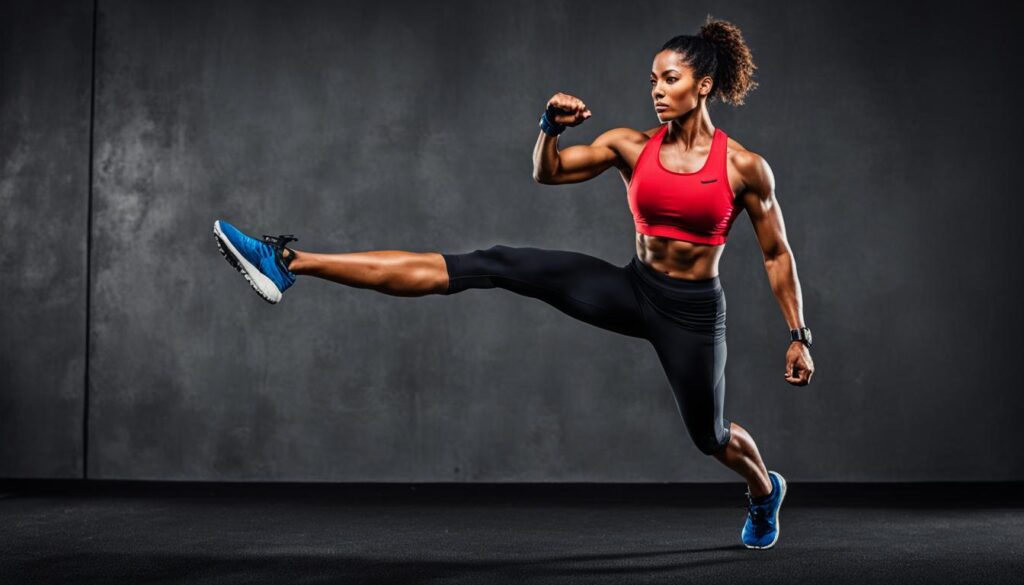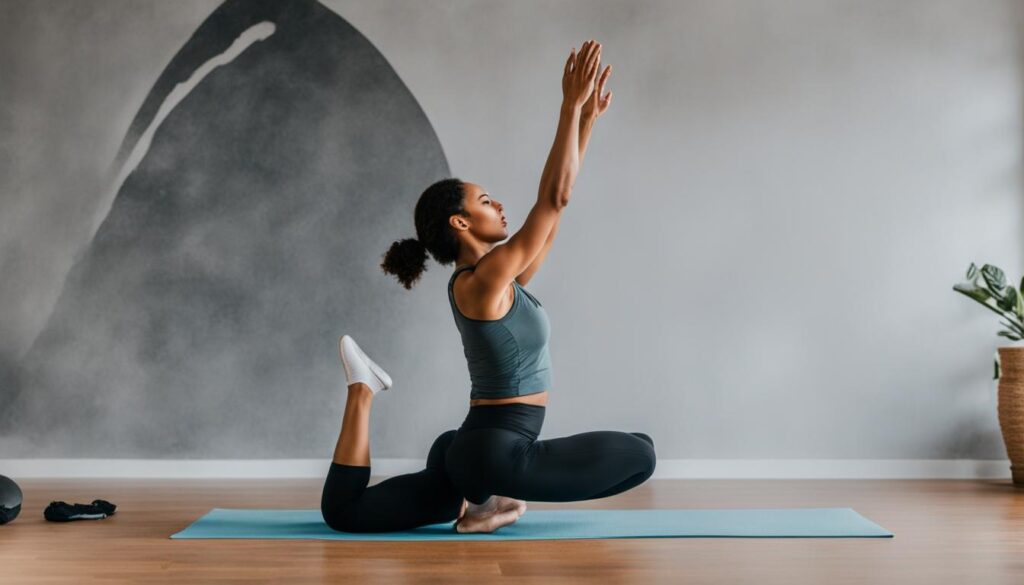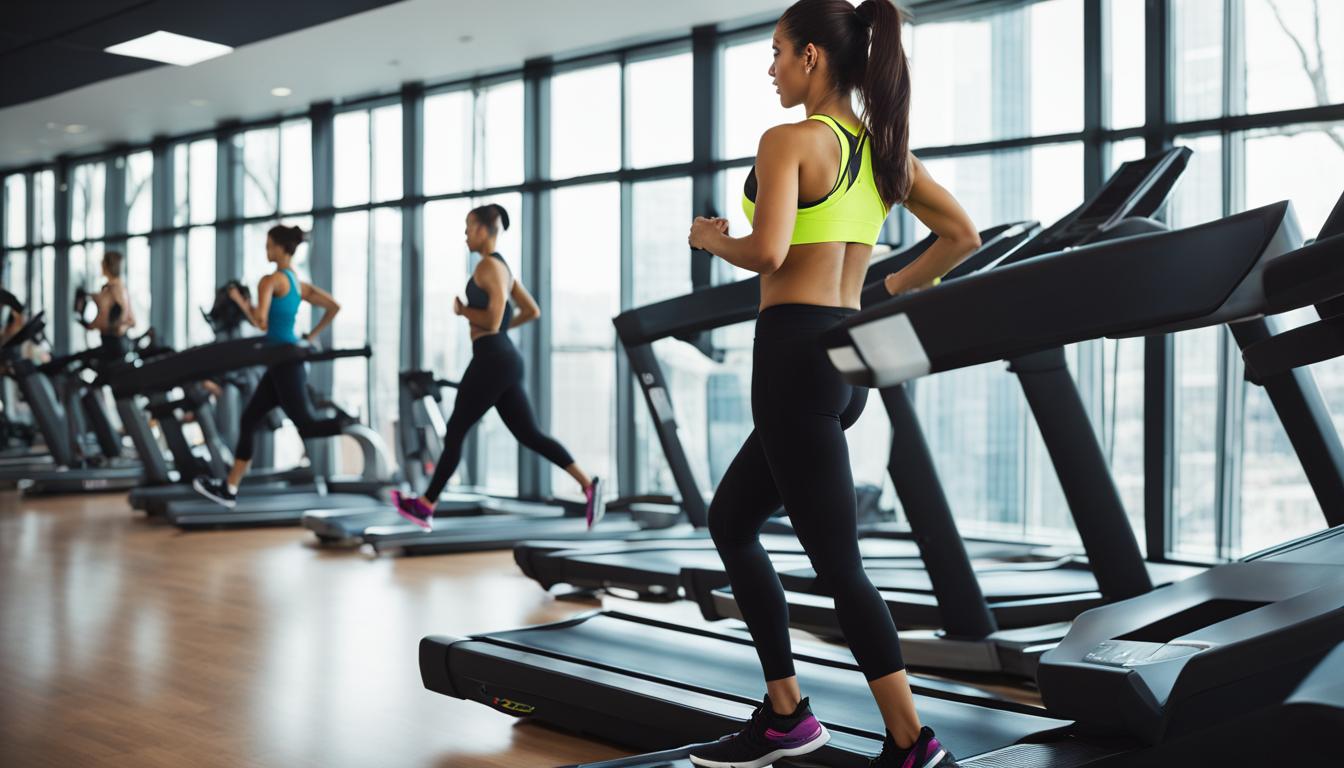Improving cardiovascular fitness is essential for weight loss and overall health. Bodyweight cardio exercises provide an effective way to burn calories and improve cardio fitness without the need for equipment. In this article, I will explore the top bodyweight cardio moves that can help you achieve your weight loss goals.
Key Takeaways:
- Bodyweight cardio moves are a convenient and effective way to burn calories and improve cardiovascular fitness.
- These exercises require no equipment and can be done anywhere, making them perfect for at-home workouts.
- High intensity interval training (HIIT) and bodyweight circuit training are great ways to incorporate bodyweight cardio moves into your routine.
- Consistency is key when it comes to seeing results from bodyweight cardio exercises. Aim for regular workouts to maximize weight loss.
- Remember to warm up properly and listen to your body to avoid injury during your bodyweight cardio training sessions.
The Benefits of Bodyweight Cardio Training
Bodyweight cardio training offers numerous benefits for weight reduction. It improves cardiovascular fitness, leading to increased stamina and endurance. These exercises also burn calories and facilitate fat loss. Additionally, bodyweight cardio moves help strengthen muscles and can be done conveniently at home.
Cardiovascular fitness is vital for overall health and weight management. Engaging in bodyweight cardio training helps to improve your heart and lungs’ ability to deliver oxygen-rich blood to your muscles, thus enhancing your cardiovascular fitness. By regularly performing bodyweight cardio exercises, such as jumping jacks, high knees, or mountain climbers, you can boost your cardiovascular endurance and increase your overall stamina.
One of the significant benefits of bodyweight cardio training is calorie burn. These exercises are typically high-intensity and engage multiple muscle groups simultaneously, leading to a higher calorie expenditure. Whether you’re performing a series of high-intensity interval training (HIIT) moves or a bodyweight circuit, the intensity and duration of these workouts can contribute to greater calorie burn.
In addition to burning calories, bodyweight cardio exercises also support fat loss. The high-intensity nature of these workouts helps to elevate your heart rate and keep it elevated throughout the session. This sustained elevated heart rate encourages your body to tap into its fat stores for energy, leading to fat loss over time. Combining bodyweight cardio training with a healthy diet can further enhance your fat loss goals.
Another advantage of bodyweight cardio training is its ability to strengthen muscles. Many bodyweight cardio exercises, such as squats, lunges, and push-ups, work multiple muscle groups simultaneously, providing both cardio and strength benefits. As you perform these exercises regularly, your muscles adapt and grow stronger, leading to improved muscle tone and definition.
Bodyweight cardio training is also highly convenient, particularly for those who prefer working out at home. You don’t need any equipment to perform these exercises, making them accessible to anyone, regardless of their fitness level or training environment. Additionally, bodyweight cardio workouts can be modified to suit limited space, making them ideal for home workouts.
In conclusion, bodyweight cardio training offers a range of benefits for weight reduction and overall fitness. By improving cardiovascular fitness, burning calories, aiding fat loss, strengthening muscles, and providing convenience for home workouts, these exercises can be an effective component of your fitness routine.
Best Bodyweight Cardio Exercises for Weight Reduction
When it comes to weight reduction, incorporating bodyweight cardio exercises into your routine can be highly effective. These exercises not only help burn calories but also improve cardiovascular fitness. Below, we’ve listed the best bodyweight cardio exercises that can aid in weight reduction:
1. Bodyweight Squat
The bodyweight squat is a fundamental exercise that targets the lower body, particularly the quadriceps, hamstrings, and glutes. It also engages the core muscles for stability.
2. Burpee
The burpee is a full-body exercise that combines cardio and strength training. It targets multiple muscle groups, including the chest, shoulders, arms, legs, and core. Burpees are great for boosting endurance and burning calories.
3. Mountain Climber
The mountain climber is an intense exercise that works the entire body, focusing on the core, shoulders, and legs. It also improves coordination and stability.
4. High Knee Skip
The high knee skip is a dynamic exercise that elevates the heart rate and engages the lower body muscles, including the quadriceps, hamstrings, and calves. It also works the core.
5. Iceskater
The iceskater exercise mimics the lateral movements of ice skating and targets the lower body, including the glutes, quadriceps, hamstrings, and calves. It helps improve balance and leg strength.
6. Turkish Get Up
The Turkish get-up is a complex exercise that involves full-body coordination and strength. It primarily targets the core, shoulders, and hips.
7. Triple Extension
The triple extension exercise focuses on explosive power and targets the muscles involved in jumping and sprinting: the calves, quadriceps, and glutes. It helps improve speed and agility.
8. Windmill Side Lunge
The windmill side lunge is a dynamic exercise that targets the inner and outer thighs, glutes, and core. It also enhances lower body flexibility and balance.
9. Bear Crawl
The bear crawl is a challenging exercise that targets the entire body, focusing on the shoulders, core, and quadriceps. It improves stability and coordination.
10. Leopard Crawl
The leopard crawl is a crawl variation that engages the entire body, particularly the core, shoulders, and quadriceps. It challenges stability and strengthens muscles.
11. Short Sprint
Short sprints are high-intensity exercises that elevate the heart rate and engage the muscles of the lower body. They are great for improving cardiovascular fitness and burning calories.
Performing a combination of these bodyweight cardio exercises can provide a varied and effective workout for weight reduction. Remember to start at a comfortable intensity and gradually increase the difficulty as your fitness level improves.
| Exercise | Targeted Muscles | Benefits |
|---|---|---|
| Bodyweight Squat | Quadriceps, Hamstrings, Glutes, Core | Strengthens lower body, improves stability |
| Burpee | Chest, Shoulders, Arms, Legs, Core | Full-body cardio and strength exercise |
| Mountain Climber | Core, Shoulders, Legs | Improves coordination, targets multiple muscles |
| High Knee Skip | Quadriceps, Hamstrings, Calves, Core | Elevates heart rate, enhances leg strength |
| Iceskater | Glutes, Quadriceps, Hamstrings, Calves | Improves balance, targets lower body muscles |
| Turkish Get Up | Core, Shoulders, Hips | Full-body coordination and strength exercise |
| Triple Extension | Calves, Quadriceps, Glutes | Enhances explosive power, improves speed |
| Windmill Side Lunge | Inner Thighs, Outer Thighs, Glutes, Core | Enhances lower body flexibility and balance |
| Bear Crawl | Shoulders, Core, Quadriceps | Improves stability and coordination |
| Leopard Crawl | Core, Shoulders, Quadriceps | Strengthens muscles, challenges stability |
| Short Sprint | Lower Body Muscles | High-intensity cardio exercise |
How to Incorporate Bodyweight Cardio Exercises into Your Training

To effectively incorporate bodyweight cardio exercises into your training routine, it is essential to follow a specific programming method. By implementing circuit training or interval training with bodyweight moves, you can maximize the benefits of your cardio workout and achieve optimal results. Additionally, integrating warm-up exercises and following training tips will ensure proper form and maximum effectiveness.
Circuit Training
Circuit training is a popular method for incorporating bodyweight cardio exercises into your training routine. It involves performing a series of exercises back-to-back with minimal rest in between. This method helps elevate your heart rate and provides a challenging full-body workout. Here’s an example of a bodyweight circuit training routine:
| Exercise | Reps |
|---|---|
| Jumping Jacks | 15 |
| Push-ups | 12 |
| Bodyweight Squats | 15 |
| Mountain Climbers | 10 per side |
| Plank | 30 seconds |
Interval Training
Interval training alternates between high-intensity periods and lower-intensity recovery periods. This method is highly effective for improving cardiovascular fitness and burning calories. Here’s an example of a bodyweight interval training routine:
| Exercise | Intensity | Duration | Recovery | Duration |
|---|---|---|---|---|
| High Knee Skip | High | 30 seconds | Low | 30 seconds |
| Burpees | High | 45 seconds | Low | 30 seconds |
| Mountain Climbers | High | 30 seconds | Low | 30 seconds |
| Jump Squats | High | 45 seconds | Low | 30 seconds |
Remember to adjust the intensity and duration of each exercise based on your fitness level and gradually increase them as you progress.
Warm-up Exercises
Prior to beginning your bodyweight cardio workout, it’s crucial to include a warm-up routine. Warm-up exercises help prepare your body for the workout, increase blood flow to your muscles, and reduce the risk of injury. Here are some warm-up exercises you can incorporate:
- Jumping Jacks
- Arm Circles
- High Knees
- Leg Swings
- Walkouts
Training Tips
Follow these training tips to ensure proper form and maximize the effectiveness of your bodyweight cardio exercises:
- Focus on maintaining proper form and technique throughout each exercise.
- Pay attention to your breathing and utilize proper breathing techniques.
- Keep your body properly aligned to prevent strain or injuries.
- Gradually progress in intensity and difficulty to challenge yourself and avoid plateauing.
- Stay consistent with your workouts to see improvements over time.
- Allow for adequate recovery and listen to your body’s signals.
Incorporating bodyweight cardio exercises into your training routine can be a highly effective way to improve cardiovascular fitness and achieve your weight loss goals. By following proper programming, warming up, and incorporating training tips, you can maximize the benefits of bodyweight cardio training and make significant progress in your fitness journey.
Programming an Effective Bodyweight Cardio Workout
To create an effective bodyweight cardio workout, careful programming is essential. This involves selecting the right exercises, determining the appropriate number of reps and sets, choosing rest intervals, and incorporating progression over time. By following these steps, you can design a workout that targets your weight reduction goals and maximizes intensity.
Exercise Selection
When programming a bodyweight cardio workout, it’s important to choose exercises that engage multiple muscle groups and elevate your heart rate. This ensures a comprehensive cardiovascular and strength-training session. Examples of effective bodyweight cardio exercises include burpees, mountain climbers, high knee skips, and iceskaters.
Reps and Sets
Determining the number of reps and sets for each exercise depends on your fitness level and goals. Beginners may start with lower reps and gradually increase over time, while advanced individuals may perform higher reps to challenge their endurance. Aim to complete 2-3 sets of each exercise with a consistent number of reps, focusing on maintaining proper form throughout.
Rest Intervals
Rest intervals between sets play a crucial role in bodyweight cardio workouts. Shorter rest intervals, such as 30-45 seconds, can help maintain an elevated heart rate and increase the overall intensity of the workout. However, if you need more time to recover, longer rest intervals of 60-90 seconds are also acceptable. Adjust the rest periods based on your fitness level and comfort.
Progression
As you become more comfortable with your workout, it’s important to incorporate progression to continue challenging your body and stimulating weight reduction. You can increase the difficulty of exercises by adding variations or increasing the number of reps or sets. Gradually introduce new exercises and progressions over time to prevent plateauing and ensure continuous improvement.
Intensity
The intensity of your bodyweight cardio workout directly impacts its effectiveness in achieving weight reduction. Adjust the intensity based on your fitness level and comfort, aiming for a challenging but manageable level. As you progress, gradually increase the intensity by performing exercises at a faster pace, reducing rest intervals, or incorporating high-intensity interval training (HIIT) techniques.
By following a well-structured program that includes exercise selection, reps and sets, rest intervals, progression, and intensity adjustments, you can create a highly effective bodyweight cardio workout that promotes weight reduction and cardiovascular fitness.
How to Warm Up Before Bodyweight Cardio Training

Prior to engaging in bodyweight cardio training, it is essential to warm up properly to prevent injuries and prepare your body for the workout. A warm-up routine can include a combination of warm-up exercises, dynamic stretches, joint mobilization exercises, activation exercises, and mobility drills. These warm-up activities help to increase blood flow, warm up muscles, and improve range of motion, setting the stage for an effective and safe bodyweight cardio session.
Warm-up Exercises
Start your warm-up with light aerobic exercises such as jogging in place or jumping jacks to increase your heart rate and get your blood flowing. Follow this with a few minutes of dynamic stretches to warm up your muscles and improve flexibility. Examples of dynamic stretches include leg swings, arm circles, and torso twists.
Joint Mobilization
Include joint mobilization exercises to warm up and activate the major joints in your body. Perform movements such as shoulder circles, wrist rolls, hip circles, and ankle rotations to increase joint mobility and prepare them for the upcoming bodyweight cardio exercises.
Activation Exercises
Activation exercises specifically target the muscles you will be working during your bodyweight cardio session. These exercises not only warm up the muscles but also help improve muscle activation and engagement during the workout. Examples of activation exercises include glute bridges, plank variations, and bird dogs. Perform a few sets of these exercises to activate the targeted muscle groups.
Mobility Drills
Mobility drills focus on improving the mobility and range of motion of your joints. These exercises help to increase your body’s ability to move efficiently and perform the bodyweight cardio moves with proper form. Some common mobility drills include hip openers, thoracic spine rotations, and ankle mobility exercises. Incorporate these drills into your warm-up routine to enhance your mobility before the main workout.
Remember, a thorough warm-up is crucial before bodyweight cardio training to reduce the risk of injuries and optimize your performance. By dedicating a few minutes to warm up with a combination of warm-up exercises, dynamic stretches, joint mobilization exercises, activation exercises, and mobility drills, you can ensure a safe and effective bodyweight cardio workout.
Tips for Effective Bodyweight Cardio Training

When it comes to bodyweight cardio training, there are a few key tips to keep in mind to maximize its effectiveness. By focusing on form and technique, utilizing proper breathing techniques, maintaining proper alignment, gradually progressing in intensity and difficulty, staying consistent with your workouts, and prioritizing recovery, you can take your training to the next level.
Form and technique are crucial in any exercise, and bodyweight cardio training is no exception. Ensure that you are performing each movement with proper form to target the intended muscles and minimize the risk of injury. Take the time to learn and understand the correct technique for each exercise.
Breathing techniques play a significant role in bodyweight cardio training. Proper breathing can help you maintain control and rhythm during your workouts. Breathe in through your nose and out through your mouth, coordinating your breath with each movement. This will provide your body with the necessary oxygen and help you maintain focus.
Proper alignment is essential for optimal performance and injury prevention. Maintain a neutral spine, engage your core muscles, and align your body in the correct positions for each exercise. Pay attention to your posture and make adjustments as necessary.
Gradual progression is key to making consistent progress in your bodyweight cardio training. Start with exercises that match your fitness level and gradually increase the intensity and difficulty as you get stronger and more comfortable. This will challenge your body and help you continue to improve.
Consistency is crucial for achieving results in any fitness routine, including bodyweight cardio training. Make it a habit to incorporate these exercises into your weekly workouts and stick to a schedule. Consistency will help you build strength, endurance, and cardiovascular fitness over time.
Recovery is often underestimated but is just as important as the actual training. Allow your body time to rest and recover after each workout. Get ample sleep, hydrate well, and prioritize rest days to give your muscles time to repair and grow stronger. Incorporate stretching and foam rolling into your routine for additional recovery benefits.
By implementing these tips into your bodyweight cardio training, you can enhance your performance, minimize the risk of injury, and achieve your fitness goals more effectively.
Stay tuned for the next section where we will dive deeper into the benefits of bodyweight cardio training for weight reduction.
| Tips for Effective Bodyweight Cardio Training |
|---|
| Form and Technique |
| Breathing Techniques |
| Proper Alignment |
| Gradual Progression |
| Consistency |
| Recovery |
Can Aerobic Dance Moves be Included in a Bodyweight Cardio Workout for Weight Loss?
Yes, aerobic dance moves for weight loss can definitely be included in a bodyweight cardio workout. Aerobic dance workouts are a fun and effective way to burn calories, improve cardiovascular health, and tone muscles. By incorporating these moves into your routine, you can enhance the overall benefits of your bodyweight cardio workout.
Benefits of Bodyweight Cardio Training for Weight Reduction

When it comes to weight reduction, bodyweight cardio training offers a multitude of benefits. Regular cardiovascular exercise not only improves your heart health but also plays a crucial role in aiding weight loss. Additionally, it helps in toning your muscles, boosts your metabolism, increases energy levels, and promotes mental well-being.
Incorporating bodyweight cardio exercises into your routine can contribute to overall weight reduction and improved fitness. By engaging in cardiovascular activities that use your body’s weight as resistance, you can effectively burn calories, shed excess pounds, and build a strong, lean physique. As a result, you’ll not only achieve your weight loss goals but also enjoy the added benefits of enhanced cardiovascular health and increased muscle tone.
Regular bodyweight cardio training helps to boost your metabolism, allowing your body to efficiently burn calories throughout the day. This metabolic boost not only aids in weight loss but also contributes to maintaining a healthy weight in the long run.
Furthermore, engaging in bodyweight cardio exercises increases your energy levels, leaving you feeling more energized throughout the day. The improvement in cardiovascular endurance and overall fitness promotes mental well-being, reducing stress levels and boosting mood.
So why wait? Start incorporating bodyweight cardio training into your fitness routine today to enjoy the numerous benefits it offers for weight reduction, cardiovascular health, muscle toning, metabolism boost, energy levels, and mental well-being.
Expert Tip:
“Consistency is key when it comes to bodyweight cardio training. Aim to incorporate these exercises into your routine at least 3-4 times a week to maximize the benefits.”
Conclusion
Incorporating bodyweight cardio moves into your training routine is an excellent way to achieve weight reduction and improve your cardio fitness. These exercises offer convenience and effectiveness, allowing you to workout anytime and anywhere without the need for equipment. By following proper programming and warm-up guidelines, you can maximize the benefits of bodyweight cardio training and reach your weight loss goals.
Bodyweight cardio moves provide a comprehensive workout that engages multiple muscle groups, elevates your heart rate, and burns calories effectively. Whether you choose bodyweight squats, burpees, mountain climbers, or other dynamic exercises, you can enjoy the benefits of cardiovascular training while toning your muscles.
Consistency is key in achieving weight reduction and improving your cardio fitness. Make it a habit to include regular bodyweight cardio exercises in your training routine. With dedication and commitment, you’ll start to see progress and enjoy the positive impact on your overall health and well-being.
So, get started on your bodyweight cardio journey and experience the transformative effects of these exercises. Whether you’re a beginner or an experienced fitness enthusiast, bodyweight cardio moves are a versatile and accessible way to enhance your fitness, shed unwanted pounds, and improve your cardiovascular health.
Source Links
- https://barbend.com/bodyweight-cardio-exercises/
- https://greatist.com/fitness/cardio-bodyweight-exercises
- https://marathonhandbook.com/bodyweight-cardio-exercises/




